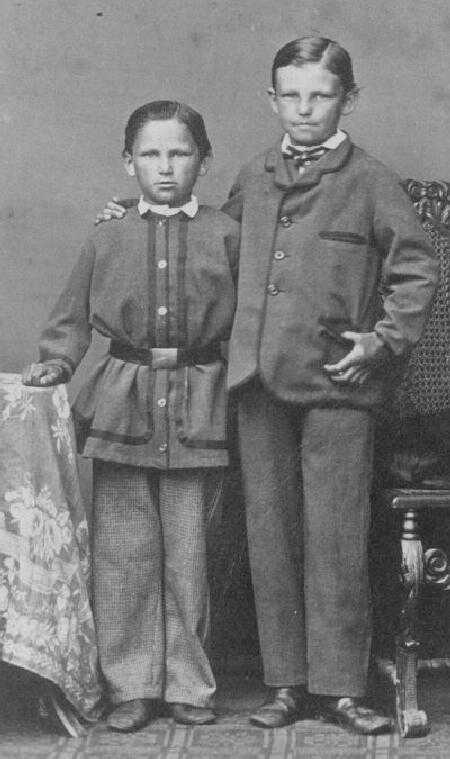
German Boys' Tunics: Chronology--1860s

Figure 1.--These brothers had their portrait taken we think in the 1860s. The CDV had no markings, but we are fairly confident the boys are German. The older boy wears a suit jacket with lapels. His younger brother wears what we would call a tunic, although we do not know what it was called at the time. Note the small collars and long pants. Also note the colored braid used a decoration. Image courtesy of the BP collection.
|
|
We note quite a number of portraits that seem to have been taken in the 1860s with German boys wearing various syles of tunics. Virtually all of the tunics we have found in the 1860s were worn with a belt or some kind of waist band. We are not entirely sure why, but this appears to have been popular because it had a military look. A belt over a tunic has no real practical purpose. The boys wering tunics seem to be up to about 10 years of age. Our archive is not yet large enough to form any definitive conclusions. The image here suggests the age conventions, the boys look to be about 8-9 and 11 years of age (figure 1). These tunics were often collarless garments, but we see some with small collars. We see them with different styles of shirt collars. In most cases they are wearing long pants. This appears to have been a style particularly popular in Germany. We see relatively few American boys wearing tunics in the 1860s. A German reader writes, "The jackets [tunics] like the one here were mostly belted. I have several in my collection, but unfortunately they are not dated. We believe that this one was taken in the 1860s. Similar ones may also have been taken in the 70s." We believe a social class factor was involved here. The tunic seems to be a garment for middle- and upper-class children. We do not see working-class children wearing them. Of course the photograohed record is somewhat misleading as working-class parents had fewer portrits taken, especially when CDVs first appeared.
Popularity
The tunic appears to have been a popular boy's garment in the 1860s. We note quite a number of portraits that seem to have been taken in the 1860s with German boys wearing various syles of tunics.
Belts
Virtually all of the Gdrman tunics we have found in the 1860s were worn with a belt or some kind of waist band. We are not entirely sure why, but this appears to have been popular because it had a military look. A belt over a tunic has no real practical purpose. It obviously could not hold up the boy's pants unless worn under the tunic. The belt was an entirely dcorative item. We note different kinds of belts.
The German boys we have noted eraring tunics in the 1860s seem to range from about 5-10 years of age, perhaps slightly older. Our primary source is the photographic record. Our archive of dated ages is not yet large enough to form any definitive conclusions, although we can often identify 1860s portraits. And we think the 5-10 year asessmnt does cover the bulk of the boys wearing tunics. As a result the tunic became a common school garment. Most boys began going to school about the same time they began wearing tunics, about 6 years of age. The image here suggests the age conventions, the boys look to be about 8-9 and 11 years of age (figure 1). We hope to be able to deal with this more conclusively as HBC expands. We do not find many pre-school German boys wearing tunics. Nor have we found images of teeenagers wearing tunics. Of course many portraits do not infdicate the age of the individual subjects, but ages can be estimted to a reasonale degree of accuracy. It is finding dated images that is importat here.
These tunics were often collarless garments, but we see some with small collars. We see them with different styles of shirt collars. The lengths are mostly short. They vary from just a little below the waist mid-thigh like the one the boy here is wearig (figure 1). In most cases they are wearing long pants. This appears to have been a style particularly popular in Germany. We see relatively few American boys wearing tunics in the 1860s. A German reader writes, "The jackets [tunics] like the one here were mostly belted. I have several in my collection, but unfortunately they are not dated. We believe that this one was taken in the 1860s. Similar ones may also have been taken in the 70s." We believe a social class factor was involved here. The tunic seems to be a garment for middle- and upper-class children. We do not see working-class children wearing them. Of course the photographed record is somewhat misleading because working-class parents had fewer portrits taken, especially when CDVs first appeared in the 1860s. A CDV cost much less than a Dag or Ambro, but were still expensive for working-class parents.
Detailing
Tunics were detailed in various ways. Some tunics were plain. The tunic here has stripe detailing (figure 1).
HBC

Navigate the Historic Boys' Clothing Web Site:
[Return to the Main German tunic 19th century chronology page]
[Return to the Main German tunic chronology page]
[Introduction]
[Activities]
[Biographies]
[Chronology]
[Clothing styles]
[Countries]
[Girls]
[Bibliographies]
[Contributions]
[FAQs]
[Glossaries]
[Images]
[Links]
[Registration]
[Tools]
[Boys' Clothing Home]
Created: 6:49 AM 6/11/2007
Last updated: 3:12 AM 2/21/2014


